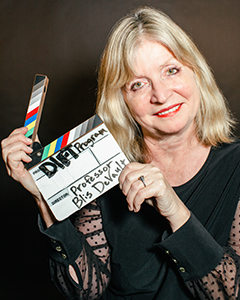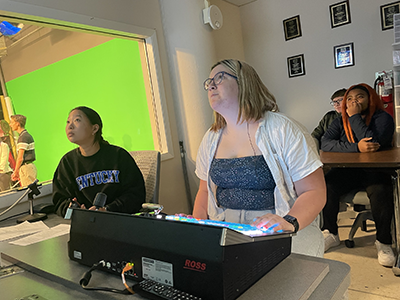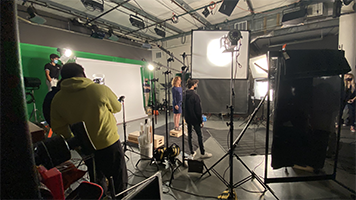
50 Years of Electronic Media at Xavier
Mar 3, 2023
The Film and Television Center is the hub of the DIFT program. It contains the studio, control room, sound booth, lab space, storage and one small bathroom. It’s where students practice the skills of their profession – filming an interview, directing a newscast, reporting a story, being the anchor. They attend class in the studio. They edit film and scripts on any of 18 computer monitors lined up edge to edge in the lab. They come in to check out the equipment they need for their senior projects, filling up to four carloads with gear. They come to rehearse the news show, meet with their professors, be with their TV club comrades. They come to connect.
Professor Blis DeVault, director of the DIFT program, said the curriculum emphasizes all facets of visual story-telling and digital media production and technologies for an industry that today requires people who can perform a variety of roles. Students learn how to produce TV news shows, how to create documentaries and narrative films, how to write scripts and edit video. “We are a script-to-screen program,” DeVault said. “Having an idea is easy. Getting it on paper and onto the screen is hard, but it’s so rewarding, and the pay-off is senior screening night. Then they go off and get really great jobs. They’re always texting me. It doesn’t stop for me when they graduate.”
“We are a script-to-screen program,” DeVault said. “Having an idea is easy. Getting it on paper and onto the screen is hard, but it’s so rewarding, and the pay-off is senior screening night. Then they go off and get really great jobs. They’re always texting me. It doesn’t stop for me when they graduate.”
Their success begins in the classroom, she said, where she and her team make sure the students are ready.
“To be successful, you have to have an environment where you feel supported and comfortable trying new things. Our goal is to be that responsive classroom creating an environment where people are supportive and students can make mistakes and learn and get constructive feedback. I’m pretty lucky I get to work with these students and walk with them their entire journey. I can’t imagine a better job.”
The program is growing in popularity. Under the leadership of Devault and her team, including Jon Nicholas, studio manager and Teaching Professor Kyle Howland, the number of students majoring or minoring in DIFT has leapt from 22 to 70 this year, after peaking at about 80 before COVID hit in 2020. There have been 164 graduates from the program since 2009.
Mayne Swift, a junior DIFT major, said the DIFT program is the reason she chose Xavier.  “It was the most inclusive DIFT major of all the colleges I looked at,” she said. “It offered more opportunities and a wider range of skills. While other programs were mostly post-production, Xavier offers more. I was really excited about cinematography and directing and screenwriting. I like writing scripts, but I also like being on set. I like every aspect of production, and I love seeing it come to life.”
“It was the most inclusive DIFT major of all the colleges I looked at,” she said. “It offered more opportunities and a wider range of skills. While other programs were mostly post-production, Xavier offers more. I was really excited about cinematography and directing and screenwriting. I like writing scripts, but I also like being on set. I like every aspect of production, and I love seeing it come to life.”
Swift sees herself going to work for a major television network such as The CW, Netflix or Hulu, or a news group like CBS or Fox, to work as a show runner helping to write, cast, produce and make decisions on set. “Xavier was exactly what I wanted – a comprehensive program.”
While Swift was the producer for the last Xavier News show of the year, fellow TV club member Lauryn McAllister, a junior who switched from political science to DIFT after taking an introductory video graphics class, was on camera that day.
“It was a gateway into that program, and so I added the class and joined the TV club and I just fell in love with it,” McAllister said. “It was something that sparked joy in me. I was excited to learn different positions and how a show was produced and how to make it just right to where it looks beautiful. That’s the part I really enjoy, learning about the aesthetics, the framing of the shots we use for the show, and I like planning and creating packages and interviewing people, and just getting that perfect shot.”
TEDI Promo from DIFT on Vimeo.
McAllister wants to work in a TV news station behind the camera or as a producer someday. But she would feel just as competent shooting her own video segments or going out on assignment as a reporter in the field. She particularly enjoyed a team assignment to create a short news video spoof about aliens landing during the Apocalypse. Their news cast depicted the anchors denying the reports while video showed aliens eating the weatherman and stalking the planet.
“What I love about the DIFT program is we’re able to have so much freedom to have creative expression,” she said.
In addition to his job as production manager at Kroger, adjunct Professor John Addino, a 1997 graduate, has been teaching in the DIFT program since 2001 and managed the studio until 2007. Part of the program’s success in preparing students for careers in film and television is its emphasis on Xavier’s mission to educate the whole student, he said. For example, every senior must complete a video project that incorporates a social justice theme.
 “It’s not just the technology. We are training the future of storytellers and teaching them in a way where the stories they tell will make a difference,” Addino said. “Since I was a student until now, it’s been a huge focus of the program, and that’s why our students are so successful. That’s the power of the program.”
“It’s not just the technology. We are training the future of storytellers and teaching them in a way where the stories they tell will make a difference,” Addino said. “Since I was a student until now, it’s been a huge focus of the program, and that’s why our students are so successful. That’s the power of the program.”
He ticked off places where some of their students are working -- Netflix, Disney, ESPN. Katie Ryan, a 2011 graduate, is now a producer for NBC News and The Today Show. “These students are going out and doing big things,” he said.
Read more in part three of our series on the history of the DIFT program at Xavier.